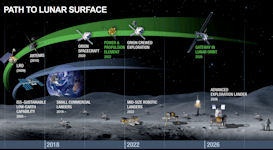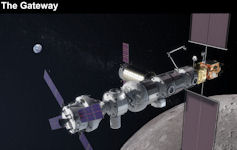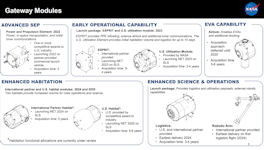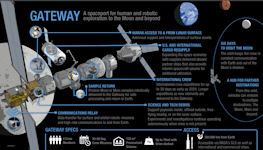Artemis - Return to the Moon - A New Moon Race ??
Advanced Cislunar and Surface Capabilities (ACSC)
NASA has said that its first crewed Artemis mission will not see a launch before 2026. This notice has come after NASA's notification of delays on Artemis-1 uncrewed flight around the Moon. The agency indicated that it would launch no earlier than May, but even that timeline is in doubt. "Given the time needed to develop and test the human landing system and NASA`s next generation spacesuits, we estimate the date for a crewed lunar landing likely to slip to 2026 at the earliest," NASA Inspector General Paul Martin was quoted as saying during a House Space and Aeronautics Subcommittee hearing on 03 March 2022. He acknowledged that the 2025 deadline that NASA is aiming for doesn`t appear to be feasible.
Martin said there are challenges that need to be faced, "not the least of which would be getting the human landing system certified to operate spacesuits," along with changes in the agency`s acquisition strategy that is expected to take more time in procuring key technologies "that are not mature". These factors, he said, "often point to taking longer and [requiring] development to get there. So 2025 is not impossible, but it seems improbable."
According to William Russell, the US Government Accountability Office director of contracting and national security acquisitions, the problem is that NASA is seeking to manage "multiple risks simultaneously" while achieving a tight deadline, the report said. Russell pointed to factors such as the seven-month delay induced by the HLS disputes, a key change in spacesuit development to pivot the work to a contractor instead of in-house work, and cost growth for the Space Launch System rocket and other key infrastructure required to support a human landing.
The US authorities plan to land astronauts on the moon in 2025, but do not exclude the possibility of postponing the mission to a later date. "We will not send astronauts until it is safe to do so. If this means a delay, then we will postpone [the flight]. However, we have every reason to believe that we are on schedule," NASA chief Bill Nelson said 03 May 2022 at a hearing in one of the committees of the Senate of the US Congress. In the spring of 2019, NASA announced a project for the Artemis lunar program in three phases. In the third phase, the US space agency expects to deliver astronauts to the moon and then send them to Mars. The timing of the stages of the program was constantly changing due to various difficulties. Until recently, NASA insisted on continuing preparations for landing people on the moon in 2024. At the end of 2021, Nelson acknowledged that these plans were technically unfeasible. He stressed that the deadlines will have to be shifted until at least 2025.
NASA selected SpaceX to land the first astronauts on the surface of the Moon since 1972, the agency said 16 April 2021, in a huge victory for Elon Musk's company. The contract, worth $2.9 billion, involved the prototype Starship spacecraft that was being tested at SpaceX's south Texas facility. "Today I'm very excited, and we are all very excited to announce that we have awarded SpaceX to continue the development of our integrated human landing system," said Lisa Watson-Morgan, NASA's Human Landing System program manager.
SpaceX beat out Jeff Bezos' Blue Origin and defense contractor Dynetics to be the sole provider for the system, a surprising break from the past when NASA has chosen multiple companies in case one fails. Industry analysts said the decision underscored the company, founded by Musk in 2002 with the goal of colonizing Mars, as NASA's most trusted private sector partner.
But legal challenges from rivals Dynetics and Amazon mogul Jeff Bezos’s Blue Origins caused NASA to suspend work on the project. “NASA instructed SpaceX that progress on the HLS contract has been suspended until GAO resolves all outstanding litigation related to this procurement,” spokeswoman Monica Witt said on Friday, citing protests from the two rivals. HLS refers to the human landing system, NASA-speak for the lunar lander intended to be used in the Artemis program, the ambitious US project to land the first woman and “the first person of color” on the Moon. The decision came just two weeks after NASA announced that SpaceX would get the “firm-fixed price, milestone-based contract” with a $2.89 billion total award value. Musk’s Starship was selected as the basis for the HLS, beating out the proposals by Blue Origins and Dynetics, a division of Leidos. Back in April 2020, NASA had signed a 10-month contract for $135 million with SpaceX, while giving $579 million to Blue Origins and $253 million to Dynetics for further design work on the landers.
Dynetics, the Alabama-based division of the mammoth Pentagon contractor Leidos, complained that NASA had ignored the fact that four Starships have “have exploded at various stages of their test flights in recent months,” according to Space News. In the complaint, filed 26 April 2021 with the Government Accountability Office, Dynetics argued that “the anti-competitive impact and downstream effect of NASA’s changed acquisition strategy cannot be overstated.”
NASA should have amended their solicitation or asked the bidders to revise their proposals, once it was clear Congress would give it only 25% of the $3.3 billion requested for the fiscal year 2021, the company said 26 April 2021. Blue Origins also challenged the decision on Monday, arguing that there were “errors” in the process that “needed to be addressed and remedied.” SpaceX founder Elon Musk responded by taunting the rival company on social media.
For its Moon lander bid, SpaceX put forward its reusable Starship spacecraft, which is designed to carry large crews and cargo for deep space voyages, and land upright both on Earth and other celestial bodies. Prototypes of the vessel were being put through their paces at the company's south Texas facility, though all four versions that have so far attempted test flights have exploded.
Under the Artemis program to return humans to the Moon, NASA wanted to use the Space Launch System rocket to launch four astronauts on board an Orion crew capsule, which will then dock with a lunar space station called Gateway. Starship will be waiting to receive two crew members for the final leg of the journey to the surface of the Moon. The idea is for Gateway to be the go-between but for the initial mission Orion might dock directly with Starship, Watson-Morgan said. The astronauts would then spend a week on the Moon before boarding Starship to return to lunar orbit, then take Orion back to Earth.
Separately, SpaceX had plans to combine the Starship spaceship with its own Super Heavy rocket, to make a combined vessel that will tower 394 feet (120 meters) tall and be the most powerful launch vehicle ever deployed.
In 2019, then vice president Mike Pence challenged NASA to land the first woman and the next man on the Moon by 2024, but it's likely that timeline will be relaxed under President Joe Biden. Another change under the current administration is its stated goal of placing the first person of color on the Moon under the Artemis program.
Biden wrote on his website: "As president, I look forward to leading a bold space program that will continue to send astronaut heroes to expand our exploration and scientific frontiers through investments in research and technology to help millions of people here on Earth." Lori Garver, the NASA deputy administrator during the Obama administration, was a key speaker at the SpaceVision 2020 convention on November 7 and 8, 2020. "Managing the Earth's ability to sustain human life and biodiversity will likely, in my view, dominate a civil space agenda for a Biden-Harris administration," she said.
The Artemis mission's first launch will be Artemis I, an uncrewed test flight lasting approximately 22 to 25 days that will orbit the Moon before returning to Earth. Originally scheduled for 2020, the Artemis I launch has been postponed until late 2021. Artemis II, a crewed test flight currently scheduled for launch in 2023, will follow a similar trajectory to Artemis I, while Artemis III aims to land crew on the Moon by late 2024.
Funding for the Human Landing System (HLS) which supports development of commercial landers to carry astronauts to and from the lunar surface is another major area of uncertainty for NASA's program to achieve the 2024 crewed moon landing goal. NASA requested $3.2 billion for the program in its 2021 fiscal year budget proposal. However, a House bill passed in July 2020 provided only about $600 million.
Artemis is named after Apollo's twin sister. Artemis was the last of those maiden deities who were never affected by the blandishments of Aphrodite. Hesiod and Homer ascribe her parentage to Zeus and Leto. She is the sister of Apollo, and born in the isle of Delos. There were many points of view from which the Greeks considered this goddess, and that which is most in accordance with the popular Hellenic notion is found in Arcadia. Here she is the female sovereign of the nymphs; while in this province her sanctuaries and her temples were very numerous and of ancient foundation. Mounts Taygetus and Erymanthus were the scenes of her sylvan exploits. Here it is that she hunts in company with her nymphs, of whom twenty formed a sort of regular retinue in the chase, while the daughters of Oceanus, to the number of an additional sixty, formed her choral dances in the mountain forests. The choir of weapons of the chase — the bow, quiver, and arrows — were the workmanship of Hephaistos, while Pan provided her with hounds. Four stags with golden antlers were attached to her chariot, and formed a swift and graceful equipage.
As the sister of Apollo she is, like Apollo, armed with bow and arrows, often dealing out plague and death among animated creation, During the Trojan war she sided with the Trojans, as did her brother Apollo. Among the immortals she is the Elaphebolos, "Stag-killer", and delights in the wild tumult of the chase. But a still more ancient type of this goddess, in fact that whence the Arcadian Artemis takes its rise, is to be found in the union of "Artemis of the Stag," and Artemis, the sister of Helios, the Sun, or Apollo, in which case she would necessarily be Selene, or the Moon.
Doug Loverro, the NASA official responsible for human spaceflight programs, left the agency May 18 after less than six months on the job. Loverro stepped into the Associate Administrator for HEO replacing his predecessor, William Gerstenmaier, who had been removed from the same position less than a year ago. “The risks we take, whether technical, political, or personal, all have potential consequences if we judge them incorrectly. I took such a risk earlier in the year because I judged it necessary to fulfill our mission,” Loverro wrote in an May 19 “all hands” email to NASA employees. “Now, over the balance of time, it is clear that I made a mistake in that choice for which I alone must bear the consequences.”
He did not elaborate on what that “mistake” was. Presumably the "mistake" was with reference to the choice of human landing systems (HLS) contractors announced 30 April 2020. The winners included Jeff Bezos's Blue Origin, but did not include industry heavy-weight Boeing. Although Boeing has been a target of Donald Trump [eg the new Air Force One], the company has learned how to play ball with the White House. Among his various holdings, Jeff Bezos includes the Washington Post, an onging source of annoyance to Donald Trump. The simplest explanation is that Boeing convinced the White House that choosing Bezos over Boeing was a "mistake".
Congresswoman Kendra Horn (D-OK) said “Under this Administration, we’ve seen a pattern of abrupt departures that have disrupted our nation’s efforts at human space flight. The bottom line is that, as the Committee that oversees NASA, we need answers.” House Committee on Science, Space, and Technology Chairwoman Eddie Bernice Johnson (D-TX) said “Mr. Loverro’s resignation is another troubling indication that the Artemis Moon-Mars initiative is still not on stable footing.
Mark Sirangelo, who joined NASA less than two months earlier as special assistant to agency chief Jim Bridenstine on the Artemis project, left his post after his proposal for a “sustainable lunar campaign” was nixed by Congress. Sirangelo “was escorted out of NASA’s headquarters in Washington” after he resigned, according to two sources who spoke to Reuters, “to pursue other opportunities.” Sirangelo joined the agency in April 2019 to organize a dedicated “mission directorate” focused on achieving the goals of the Artemis project - up to and including establishing a permanent moon base.
Most importantly - and urgently - Sirangelo was responsible for developing a strategy to meet Vice President Mike Pence’s increasingly implausible 2024 deadline for Americans’ return to the moon - and his departure suggests that NASA still lacked a workable plan in place to get there.
Congress poured cold water on Sirangelo’s proposal for a dedicated Artemis mission directorate when it rejected the project’s 2020 budget, citing costs - the $1.6 billion “down payment” is just the tip of an iceberg so large Bridenstine has deliberately avoided estimating the project’s total cost. Lawmakers appeared to have seen through that trick, demanding a more detailed plan and some idea of how much it would actually take to get to the moon.
Worse, the White House’s proposal to pay for that $1.6 billion involved repurposing money from the government’s Pell Grant fund, which provides financial aid for low-income college students - not good optics for a program that requires highly-trained engineers and scientists. “We need a lot more rocket scientists, not fewer,” Rep. Kendra Horn (D-Oklahoma), chair of the House subcommittee on space and aeronautics, told the Verge.
With Sirangelo’s plan rejected, NASA will have to conduct its Artemis work under the aegis of the existing Human Exploration and Operations directorate. Details of the plan were released earlier this week, showing 37 launches of NASA and private rockets, a bevy of lunar landers both human and robotic, and finally, “Lunar Surface Asset Deployment” in 2028, presumably a prelude to permanent base operation.
The Trump Administration announced plans to return Americans to the Lunar surface by the year 2024, some five years earlier than previously planned. This biggest challenge facing NASA is the development of the lunar lander needed to take astronauts to the surface. Such a vehicle had been under development under the Bush Administration, but had been halted under the Obama Administration. NASA now faces the choice of either reviving the Bush Adminisration Altair Lunar Lander, a large, highly capable system of the sort needed for extensive Lunar operations, or developing something along the lines of the Golden Spike lander, a minimalist vehicle that would meet the immediate political "footsteps and flags" requirements, but might not support much else.
China appears to have planned to land Chinese nationals on the Lunar surface soon after the year 2030, which is when the Long March 9 superbooster would become available. Russia has plans to send cosmonauts to the Lunar surface after 2030, but unlike China, which seems to have a real program, the Russian plans remain no more than un-approved plans.
While is it vastly more difficult to put a crew on the Lunar surface, as Apollo 11 did in 1969, sending a crew to the Moon, as Apollo 8 did in 1968, is a rather easier task. Both China and Russia have hardware options to send their crews to the Moon [without landing] before the Americans can place a crew on the Moon. One or both countries may take this opportunity to embarrass the Americans [attractive to China], or to claim superpower status [attractive to Putin].
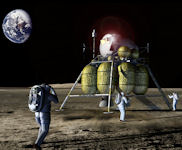 Vice President Mike Pence announced on 26 March 2019 that the United States aims to send astronauts back to the Moon in five years, with a woman first in line to set foot on it again. “It is the stated policy of this administration and the United States of America to return American astronauts to the Moon, within the next five years,” Pence said in a speech in Huntsville, Alabama. “Let me be clear, the first woman and the next man on the Moon will both be American astronauts launched by American rockets from American soil,” he said.
Vice President Mike Pence announced on 26 March 2019 that the United States aims to send astronauts back to the Moon in five years, with a woman first in line to set foot on it again. “It is the stated policy of this administration and the United States of America to return American astronauts to the Moon, within the next five years,” Pence said in a speech in Huntsville, Alabama. “Let me be clear, the first woman and the next man on the Moon will both be American astronauts launched by American rockets from American soil,” he said.
"Now, make no mistake about it: We’re in a space race today, just as we were in the 1960s, and the stakes are even higher. Last December, China became the first nation to land on the far side of the Moon and revealed their ambition to seize the lunar strategic high ground and become the world’s preeminent spacefaring nation.
"Failure to achieve our goal to return an American astronaut to the Moon in the next five years is not an option," he continued, adding that commercial rockets and contractors would be used if they were the only way to achieve the five-year goal. "If NASA is not currently capable of landing American astronauts on the Moon in five years, we need to change the organization, not the mission." In plain language: "NASA, you've got until 2024 — or you're fired."
Some believe that 2024 was chosen because, if Trump wins a second term, a lunar landing would lend him a lasting legacy just before his departure. The event would also be a welcome PR boost for his US Republican party — and right during the boiling point of the 2024 presidential and congressional elections. When US astronauts landed on the moon in July of 1969, for example, it gave then-President Nixon a temporary bump in approval ratings of about four percent. Some saw this as the real reason behind the US' new five-year plan to return human beings to the moon by 2024 instead of 2028 — domestic politics. The goal was not to win a "space race," but an election. If this were a Hollywood movie, it's the kind of twist expected from one of America's autocratic adversaries, not from America itself.
In December 2017, President Donald J. Trump gave NASA a new direction, telling the agency to work with international and commercial partners to refocus exploration efforts on the moon, with an eye to eventually going on to Mars and even beyond. As stated in Space Policy Directive-1, "The NASA Administrator shall, 'Lead an innovative and sustainable program of exploration with commercial and international partners to enable human expansion across the solar system and to bring back to Earth new knowledge and opportunities. Beginning with missions beyond low-Earth orbit, the United States will lead the return of humans to the Moon for long-term exploration and utilization, followed by human missions to Mars and other destinations.' ”
NASA Administrator Jim Bridenstine said March 11, 2019: “Beginning with a series of small commercial delivery missions to the Moon as early as this year, we will use new landers, robots and eventually humans by 2028 to conduct science across the entire lunar surface." But later Administrator Jim Bridenstine said “ President Donald Trump has asked NASA to accelerate our plans to return to the Moon and to land humans on the surface again by 2024. We will go with innovative new technologies and systems to explore more locations across the surface than was ever thought possible. This time, when we go to the Moon, we will stay. And then we will use what we learn on the Moon to take the next giant leap - sending astronauts to Mars ”
On 30 April 2020 NASA selected three U.S. companies to design and develop human landing systems (HLS) for the agency’s Artemis program, one of which will land the first woman and next man on the surface of the Moon by 2024. NASA is on track for sustainable human exploration of the Moon for the first time in history. The human landing system awards under the Next Space Technologies for Exploration Partnerships (NextSTEP-2) Appendix H Broad Agency Announcement (BAA) are firm-fixed price, milestone-based contracts. The total combined value for all awarded contracts is $967 million for the 10-month base period.
Notably absent from the winners was Boeing, which announced in November it had proposed a lunar lander system that could be launched in one piece on the SLS. None of the three companies proposed using the Space Launch System for their lunar landers. Blue Origin said their lander can launch either on its own New Glenn vehicle or United Launch Alliance’s Vulcan, while Dynetics baselined Vulcan and SpaceX its own Super Heavy booster for Starship. SLS will still be used for launching the crewed Orion spacecraft to lunar orbit.
NASA’s commercial partners will refine their lander concepts through the contract base period ending in February 2021. During that time, the agency will evaluate which of the contractors will perform initial demonstration missions. NASA will later select firms for development and maturation of sustainable lander systems followed by sustainable demonstration missions. NASA intends to procure transportation to the lunar surface as commercial space transportation services after these demonstrations are complete. During each phase of development, NASA and its partners will use critical lessons from earlier phases to hone the final concepts that will be used for future lunar commercial services.
NASA on 04 April 2023 named the first woman and the first African American ever assigned as astronauts to a lunar mission, introducing them as part of the four-member team chosen to fly on what would be the first crewed voyage around the moon in more than 50 years. Christina Koch, an engineer who already holds the record for the longest continuous spaceflight by a woman and was part of NASA's first three all-female spacewalks, was named as a mission specialist for the Artemis II lunar flyby expected as early as next year. She will be joined by Victor Glover, a US Navy aviator and veteran of four spacewalks who NASA has designated as pilot of Artemis II. He will be the first Black astronaut ever to be sent on a lunar mission. Rounding out the four-member crew are Jeremy Hansen, a Royal Canadian Air Force colonel and first Canadian ever chosen for a flight to the moon, as a mission specialist, and Reid Wiseman, another former US Navy fighter pilot, named as Artemis II mission commander.
|
NEWSLETTER
|
| Join the GlobalSecurity.org mailing list |
|
|
|

